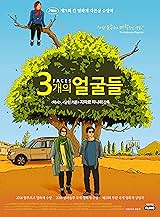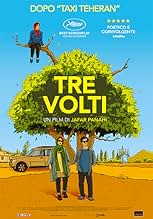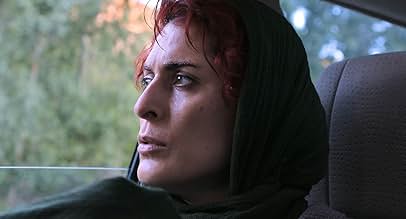Tres actrices en diferentes puntos de sus carreras: un estrella actual, una de antes de la Revolución Islámica de 1979, y una joven con esperanzas de tomar clases de arte dramático.Tres actrices en diferentes puntos de sus carreras: un estrella actual, una de antes de la Revolución Islámica de 1979, y una joven con esperanzas de tomar clases de arte dramático.Tres actrices en diferentes puntos de sus carreras: un estrella actual, una de antes de la Revolución Islámica de 1979, y una joven con esperanzas de tomar clases de arte dramático.
- Dirección
- Guionistas
- Elenco
- Premios
- 5 premios ganados y 9 nominaciones en total
- Marziyeh's mother
- (as Narges Del Aram)
- Karbalaei
- (as Ahmad Naderi Mehr)
- Sorkhpost
- (sin créditos)
- Dirección
- Guionistas
- Todo el elenco y el equipo
- Producción, taquilla y más en IMDbPro
Opiniones destacadas
Couple of comments: this is the latest movie from writer-director Jafar Panahi, who in 2010 was banned by the Iranian authorities from making any more movies. Panahi's excellent 2011 movie "This Is Not a Film" was the first to be made during that ban, and "3 Faces" is the 4th. Working on a micro-budget and at great personal risk, Panahi and his crew nevertheless manage to brings us a riveting film about what life in rural Iran is really like., and the cost in terms of the human condition. In other words, this is the perfect opposite of the latest Marvel superhero movie. Given the plot-heavy nature of the movie, I can't say much more.
"3 Faces" premiered at this year's Cannes film festival to universal acclaim, and Panahi won (in absentia, of course) the festival's Best Screenplay award. I'd say the chances of this movie getting an Oscar nomination for Best Foreign Language Movie are pretty good too. I happen to catch this film during a recent family visit in Belgium. The early evening screening where I saw this at in Antwerp, Belgium was not attended well (exactly 5 people, myself included). Regardless, if you are in the mood for a top notch foreign film that was made despite a ban on the director, I'd readily suggest you check this out, be it in the theater (if and when this reaches US theaters), on VOD, or eventually on DVD/Blu-ray, and draw your own conclusion.
Prior to the Iranian Revolution of 1980, cinema in Iran was very popular. The country had a mature film-making industry that churned out products ranging from adventure films with virile male characters to important art films from internationally-recognized directors such as Abbas Kiarostami.
After the Ayatollah took over the country, these films were banned. Some artists managed to flee the country while others stayed and became outcasts like the old actress in this movie. Panahi intentionally never shows us her face, a reminder that Iranians are not permitted to view the films that comprise Iranian cinematic heritage. The old actress lives in a very humble house in a remote part of a very remote village, in the same way that Iranian film history exists, but has been tucked away from view by the mullahs, and stuck into a place unfitting its true stature. There is a very interesting scene in which, from a distance, Panahi sees all three actresses dancing and partying in the house. It is as if he is saying he knows there is a lot of great substance in the historic Iranian films, but he himself cannot enjoy it, given his own present circumstance as an Iranian filmmaker whose films are banned in his own country.
The middle-aged actress (played brilliantly by Behnaz Jafari) represents the current state of Iranian cinema, which is to say it is practically nonexistent. In this movie she is a TV actress who stars in cheap soap operas. Early in the film, Panahi describes her as follows: "in her current state she's not much use to anyone, anyway." Ouch.
Perhaps the most interesting of the three faces is that of the young actress, who represents Panahi's assessment of the future of Iranian cinema, which turns out not to be traditional cinema at all. This actress stars in a smart phone-produced video that might or might not be staged. The filmmakers of the future, he seems to be saying, will be unconstrained by whether a work might be categorized as fiction or non-fiction, but instead focused on important sociological themes that move people to act. Indeed, a look at present day Iranian Youtube videos reveals works that deal with social upheaval. One example: a woman wears her hijab too low on the bus and films away as a religious zealot spits in her face. These are the most important films coming out of Iran today.
Beyond its subtext, this film is very rich in terms of presenting for western viewers a look at a part of the world we rarely get to see. Panahi's portrayal of the people of rural Iran along the Turkish border seems very genuine. He presents them as multifaceted and interesting; we get a good dose of the good, the bad and the ugly in these people. The film is worth seeing for that alone.
Watching this movie, I got the feeling that life in Iran's hinterlands must be a miserable existence. It's not a great movie, but worth seeing as a look at people whom we don't often see.
¿Sabías que…?
- TriviaIt is filmed in a remote Turkish-Azeri-speaking part of Iran where Panahi's parents hail from.
- Citas
Behnaz Jafari: I had reached the height of uncertainty. Wishing to know the names. The hand of the supervisor made the hammer dance in the air and broke the breath of immaculate dawn. Against the red metal tip hanging on the school pine. Sounds, rings, rings. Silence tortured innocence. The first prayer was for me an obvious curse. Standing. Sitting. I did not say: present. In this case, you are absent.
- ConexionesReferenced in Hidden (2020)
Selecciones populares
- How long is 3 Faces?Con tecnología de Alexa
Detalles
Taquilla
- Total en EE. UU. y Canadá
- USD 72,324
- Fin de semana de estreno en EE. UU. y Canadá
- USD 7,065
- 10 mar 2019
- Total a nivel mundial
- USD 2,191,516
- Tiempo de ejecución1 hora 40 minutos
- Color
- Mezcla de sonido
- Relación de aspecto
- 1.85 : 1
Contribuir a esta página

























